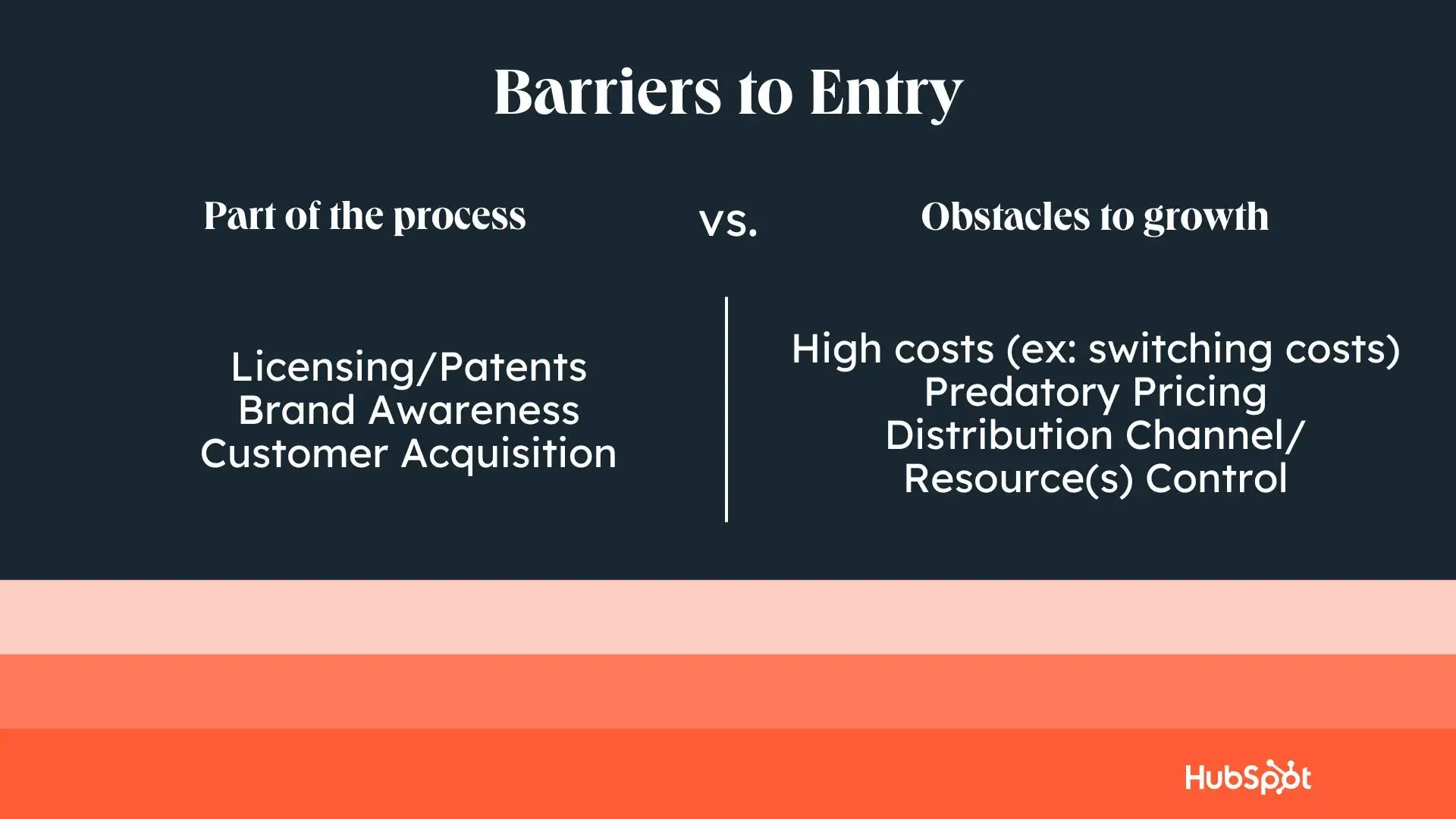In this article, I’ll explore barriers to entry for emerging entrepreneurs, everything you need to know about maneuvering them, and most importantly, I’ll share vetted insights and tips for how to overcome them. Let’s jump in.
Table of Contents:
- What are Barriers to Entry?
- Barriers to Entry Examples
- Overcoming Barriers to Entry: Expert Insights + Tips
What are Barriers to Entry?
Barriers to entry are obstacles and/or hindrances that prevent first-time business owners from entering a given market space. Although barriers to entry present challenges, they are natural to a company’s growth.
Barriers to entry can be anything: High costs, limited access to technology, regulatory hurdles, and even brand loyalty can all limit the growth of your business, at least in the short term. But, believe it not, not every barrier to entry is fundamentally “bad.” Often, barriers to entry are simply a part of the business development process.
TechCrunch reported major layoffs at UKG, eBay, PayPal, and Google for 2024, and that’s just scratching the surface. Recently, most large-scale businesses have eliminated between 3% to as much as 40% of their staff. As companies continue to undergo unprecedented restructuring and organizational layoffs, I wholeheartedly understand why more folks are looking to forge their own path, ultimately aiming to be their own boss.
But it ain’t easy. This is something that I’ve come to recognize in my own journey to understanding the challenges first-time entrepreneurs face as they navigate entering any given market space. So, let's look at some specific barriers to entry that new businesses are likely to encounter.
Barriers to Entry Examples
To help you better understand how to classify certain types of barriers to entry, I created the following comparison chart:

As a budding entrepreneur, you need to understand the difference between barriers to entry that are organic to growing your enterprise versus barriers to entry that are obstacles to growth.
For example, high costs can be considered as an obstacle to entry because, for many new business owners, the initial investment required for equipment, technology, marketing, and even office space is not readily available. It often takes a lot of grant-applying and investor-searching to secure the necessary funding.
Predatory pricing occurs when established companies deliberately lower their prices (of their products) below cost, often targeting new entrants to a market. This barrier to entry creates an uneven playing field that stifles innovation, discourages healthy competition, and limits choices for consumers.
And still, even if you do everything right, some barriers to entry are simply unavoidable. The following barriers to entry can indeed be identified as setbacks, and some of them truly are. However, they should also be assessed as expected demands of entering any market space:
1. Regulatory Compliance
Rules, paperwork, and regulations. They’re a pain, right? I know you may hate to hear this but … that’s kind of the point.
Abiding by regulations and obtaining permits is a very necessary part of establishing smooth business operations and legitimizing your company. Ensuring compliance and maintaining quality standards builds unwavering trust with customers and key stakeholders.
My suggestion for this preliminary phase is to embrace the process, even if it feels chaotic. Carve out time to complete forms step-by-step, seek guidance (from LinkedIn, Google … maybe AI …), browse through government websites, and take as long as you need to work through this stage correctly.
2. Customer Acquisition
This challenge can definitely make it tricky to get your business up and running smoothly. I mean, attracting and retaining customers is like trying to lasso a wild horse – it requires strategy, persistence, and sometimes a bit of luck.
When you're just starting out, building a customer base from scratch can feel like an uphill battle, especially when bigger, established companies already have a loyal following. But customer acquisition is a fundamental aspect of pretty much every industry there is.
After all, without customers, where would your business be?
While it may feel like a setback, mastering the art of customer acquisition is key to growing your business and carving out your place in the market. Eventually, you’ll find your tribe of loyal customers.
3. Marketing/Advertising Skills
Let’s face it, as a newbie in the biz world, you might not have the knowledge needed to develop a world-class marketing strategy. But customers need to know you exist, after all!
By cultivating the right approach to promoting your business, you can gradually build brand awareness and attract eager customers. Just take those initial steps, learn along the way, and be open to trying different frameworks to see what works best for your unique business.
Oh, and don't be too discouraged by the initial learning curve. It’s a rite of passage that everyone encounters, that’ll pay off in a big way.
4. Licensing/Patents
Securing licenses and patents can be a time-consuming and often costly process that might feel like a hurdle too high to jump over, especially when you’re just trying to get your feet off the ground.
Still, it’s important to recognize that obtaining licenses and patents is a standard requirement for starting a business. By protecting your intellectual property, you’re ensuring that your ideas are safeguarded from competitors.
Although licensing and patents may seem like an additional hoop to jump through, it’s a vital step in establishing a solid foundation for your business. The sooner you start, the sooner you’ll get through them.
And fortunately, resources like HubSpot’s business startup kit are available for free, whenever you’re ready to take that step.
How to Overcome Barriers to Entry: Expert Insights + Pro Tips
As I mentioned above, I’m not a business owner (maybe one day I will be). But I am a very curious person, so I scoured far and wide for expert opinions on how to conquer barriers to entry.
This Ted Talk titled “6 Tips on Being a Successful Entrepreneur” led by John Mullins, professor of Management Practice at London Business School and an all-things-entrepreneurship expert, focuses on counter-conventional mindsets for new business owners when confronted with obstacles. John’s forward-thinking ideology captured my attention because of its digestibility and universality.
Below are my takeaways from John’s presentation and tips that will hopefully help you surpass barriers to entry with flying colors:
Takeaway 1: Use “problem-first, not product-first” logic
Mullins says that successful entrepreneurs don’t “focus on products.” Instead, they “focus on problems.” The “problem-first, not product-first” logic insists that you are focused on the dilemmas that your target market faces, not the difficulties of the business sector itself.
Your approach to the consumer market — how you build customer relationships and loyalty — is how you solve that problem.
The bread and butter here is this: For every problem, there’s someone seeking the perfect solution. This creates opportunities for entrepreneurs to connect with consumers at different stages of their buyer’s journey.
Mullins’ wisdom is poignant for overcoming barriers to entry because it emphasizes evolving one's business approach along with the ever-changing market landscape. It’s all about perspective, folks.
Takeaway 2: Have a “Yes, we can!” mindset.
Mullins shares that having a “Yes, We Can!” mindset is an entrepreneur’s greatest weapon.
A “Yes, We Can!” mindset not only helps entrepreneurs foresee the positive aspects of potential challenges, but also equips them to approach those challenges with poise.
As opposed to accepting the impossible nature of a goal or problem, Mullins urges entrepreneurs to understand that every stage of spearheading a successful company will require a lot of risk. Yet, your biggest risk could be your best business decision.
This is definitely a skill that takes time to hone but, eventually, it becomes second nature.
Takeaway 3: Think narrow, not broad.
Finally, focus on a narrow target market to reach a unique demographic of consumers or clients. As affirmed by Mullins, this will help you attract a specific audience by addressing a specific problem.
So, discover your niche. Lean into what you think may be too particular. If you’re trying to win at large-scale competition, maybe refocus your attention on being best-in-class at differentiation.
It’s a marathon, not a sprint, my dear reader.
Go forth and be great!
With the right strategies and insights, aspiring entrepreneurs can turn seemingly impossible barriers to entry into opportunities for success.
Just because these barriers to entry exist doesn’t mean that, in the long run, you and your company won’t benefit from confronting them head on. Barriers to entry don’t have to be scary. With the right amount of strategy, confidence, determination and support, you can achieve your business goals in no time.
Remember, every successful entrepreneur had to navigate these waters at some point, so you’re not alone in this journey.
Business Growth


.png)

![How Entrepreneurs Navigated (& Survived) Recessions [New Data & Expert Tips for Economic Slumps]](https://53.fs1.hubspotusercontent-na1.net/hubfs/53/Copy%20of%20Featured%20Image%20Template%20Backgrounds%20(55).png)


![Grants for Black-Owned Businesses and Other Funding Resources for Black Business Owners [+ Deadlines for 2025]](https://53.fs1.hubspotusercontent-na1.net/hubfs/53/copy%20of%20jade%20walters%20btb%20(41).png)

%20(1)-1.png)

![Here's How to Value a Company [With Examples]](https://53.fs1.hubspotusercontent-na1.net/hubfs/53/Value%20a%20Business%20fi%20(1).png)

